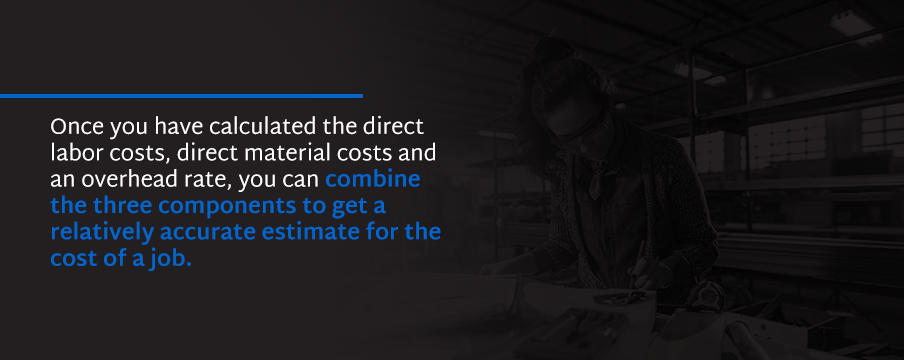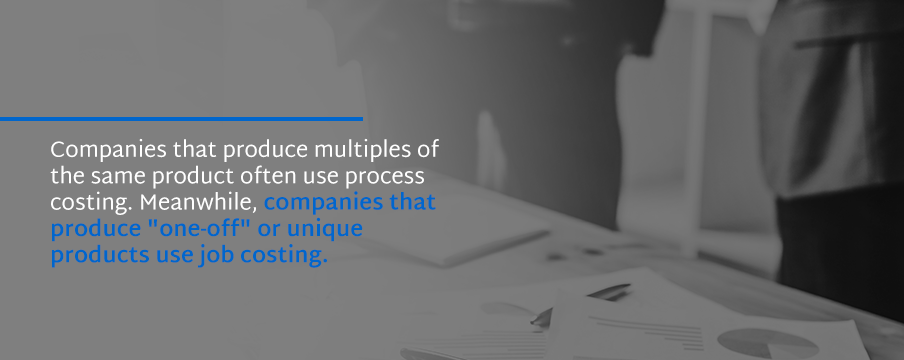Pros and Cons of Job Costing

How can you tell whether your development or construction business is turning a profit? You need to compare how much you spend on completing projects or finishing jobs to the amount your company earns from each project. If your company uses a job order costing method or system, it calculates the anticipated cost of a job before starting the project. Job costing uses detailed information to assess the profitability of a job. While it’s often a good method to use during construction projects or manufacturing projects, it’s not always the most appropriate option for every company.
Learn more about the features of job costing, its goals and how you can use it.
What Elements Are Part of the Job Costing Method?
If you are going to build a house for a client or are planning on developing land for a commercial real estate project, you need to know how much you will spend on the project or job as a whole. Knowing the cost of the job will help you determine how much to charge your customers so that you can earn a profit. Using a job costing method can also help you determine if a particular construction or development project is more profitable than another one.
To perform job costing, you need to calculate several different costs. The method involves determining the direct cost of labor and materials, as well as indirect overhead costs. Take a look at examples of direct labor, direct material and overhead costs and see how you can calculate each cost when performing job costing.
1. Direct Labor Costs
Part of determining how much a particular job will cost is determining the direct cost of labor needed to complete the job. In this case, direct labor costs refer to the cost of employing people to work on the project. It doesn’t include the cost of administrative labor or management. If your company is building a single-family home for a client, calculating the direct labor costs would involve estimating how much time your team would spend constructing the house.
Since many people are usually involved in the homebuilding process, let’s keep things on the simple side and examine the direct labor costs of a single type of worker. The carpenter you hire to work on the project costs $25 per hour. Throughout the construction process, they spend 100 hours performing carpentry. Their direct labor costs for the single-family home are $2,500.
2. Direct Material Costs
Another part of job costing is determining the cost of materials used for a project. Direct material costs include materials that are only used for one project, such as the wood or bricks used to make a house. Materials that might be purchased in bulk for use in a range of projects, such as nails, would be counted as overhead costs.
To calculate direct materials costs, you add up the amount of the material you need and multiply the number by the price of the item. For example, a carpenter might need 100 pieces of lumber when building a single-family home. Each piece costs $10. The direct materials cost for lumber is $1,000.
3. Overhead Costs
Overhead costs in the job costing method are any costs that aren’t directly connected to the job at hand. Some examples of overhead costs include:
- Cost and time of travel to and from the job site
- Cost of administrative, managerial and supervisory work
- Cost of materials used across projects
- Cost of tools and equipment, such as ladders, nail guns and levels
- Cost of insurance
- Cost of gas and vehicle maintenance
Calculating overhead costs can be more complicated than figuring the direct labor and material costs for a job. One way to go about determining overhead expenses for a job is to create and use an overhead rate. To determine your company’s overhead rate, you can work with an accountant or CFO.
With your CFO or accountant, estimate the costs of overhead, such as what you’ll pay the administrative and managerial team over the year, how much you expect to spend on transportation and insurance, the cost or depreciation of any tools used across projects and the estimated cost of shared materials.
Once you have the total estimated overhead cost, consider how many direct labor hours you anticipate your team spending over the year. You can look at past years to see how much time your employees spent on similar projects to estimate direct labor hours.
The next step is to divide your anticipated overhead costs by the expected number of direct labor hour hours for the year to determine the hourly overhead rate. For example, you and your accountant estimate that your total overhead costs for the year will be $250,000. You also expect that your team will spend 10,000 hours on building or construction projects over the year. To determine your overhead rate, divide $250,000 by 10,000 to get a rate of $25 per hour.

4. Putting It All Together
Once you have calculated the direct labor costs, direct material costs and an overhead rate, you can combine the three components to get a relatively accurate estimate for the cost of a job. For example, to build a house, you know that you will spend $2,500 on direct labor and $1,000 on direct materials. You estimate that the indirect or applied overhead will make up about 10 hours, at $25 per hour ($2,500). The cost of the job in this example is $6,000.
What Are the Goals of Job Costing?
The primary goal of job costing is to determine the overall price and profitability of a particular job. For example, a job might cost $10,000. Your company might break even on the job or end up losing money if the cost is higher than the sale price of the home. It is also possible for a job to cost $10,000 and earn a profit of $10,000.
Another goal of job costing is to help your company evaluate and determine which jobs will earn a profit and which ones won’t. With job costing, you can decide to move forward on projects that will help your bottom line. You can also choose to pass on those jobs which won’t earn money or which might end up costing more than the sale price.
You can also use job costing to figure out if a similar project you decide to work on in the future will turn a profit or not. Based on the result of one job order, you might realize that a particular type of project is a losing game. Going forward, you might decide to focus your efforts on different kinds of projects.
With job costing, you get a sense of whether your estimates were accurate or not. For example, based on your calculations, you expected a project to cost $25,000 and to earn a profit of $15,000. Once the project was over, you realized that the true cost of it was $35,000, and your profit ended up being $5,000.
You can compare the numbers used during job costing to the actual numbers to figure out what the issue was. It might be that you expected your team to spend 100 hours working on the project, at $25 per hour. It could be the case that they spent double the time estimated, 200 hours, or that individual employees worked more than 40 hour weeks regularly so that you had to pay overtime (time and a half). In either case, your direct labor costs ended up being more than planned.
Going forward, you can account for higher labor costs for similar projects to get a more accurate sense of the profitability of those projects.
Finally, one of the goals of the job costing process is to help your business maintain accurate records. When you have a complete, detailed breakdown of the costs of a particular project, such as constructing a single-family home, you have an accurate record of what your business spent on that project. Having records that are detailed and correct will help you when it’s time to make decisions about the future of your company.
What Are the Advantages and Disadvantages of Job Costing?
Along with understanding how job costing works and how your business can use it, it helps to understand and assess the pros and cons of job costing. Take a look at the advantages and potential drawbacks of using it.
Pros of Job Costing
Some of the pros of using job costing are:
- It allows you to compare the cost of a job to its profit: With the job order costing method, you can determine how much you are going to spend on a particular project in advance. You can then see how the cost of the project compares to what your company can earn.
- It allows you to determine productivity: Another benefit of job costing is that it allows you to assess your employees’ productivity. If you estimate that your team will spend X hours constructing a home, then it turns out they spend X+100 hours, you can take a closer look to see what went wrong. It might also be the case that you realize that one employee is much more productive than the others. Going forward, you might use that employee more than the people who work more slowly.
- It can help you avoid mistakes: Thanks to job costing, you have a fair idea of total costs and profitability before you begin a project. If you look at the numbers and see that a job won’t have a significant enough payoff, you can turn it down and focus your energy on more profitable opportunities.
- It can grow with your business: Construction and real estate companies large and small can use job costing to compare costs and profits. As your company takes on new projects, you can continue to use job costing.
- It helps you create a budget for your company: How much are you spending on labor or materials? What are your overhead costs? Since job costing requires you to hammer out the details for each project, it can also be a useful tool to use when putting together an overall company budget.

Cons of Job Costing
Some of the cons of job costing are:
- It can be labor-intensive: The process of job costing does require a fair amount of effort on your part. You need to have a grasp on the number of direct labor hours, the cost of direct materials and overhead costs. It can take some time to come up with the figures you need for the process to work.
- It requires a lot of documentation: Job costing can also involve a lot of paperwork and documentation. You’ll want documentation of hours worked, supplies purchased and equipment used. The more complicated the job is, the more paperwork is needed.
- It doesn’t necessarily help you control costs: Another drawback of job costing is that it might not be a useful tool for managing or minimizing costs. Job costing will show you what a project is going to cost. But you might not get a sense of what you can do to reduce expenses on a particular project. You will get a sense of whether a project is worth working on or not.
- It requires some guesswork: Especially at the beginning, there is some guesswork involved in job costing. If you are building a particular size or style of home for the first time, you might not have an accurate idea of the labor costs involved. You might underestimate those costs and miss out on profit. Or, you might turn down a job because you over-estimate labor and materials costs and determine the gain isn’t substantial enough.
Is Job Costing Right for You?
Several features of job costing can help you determine whether it’s the right method for your company to use. Job costing is often compared to process costing, another way of determining costs. Companies that produce multiples of the same product often use process costing. Meanwhile, companies that produce “one-off” or unique products use job costing.

Job costing works well for construction companies, developers and others in the real estate industry. If the following apply to your business, job costing is likely the right choice for you if:
- You produce a unique product: Job costing works best when you are making one item, rather than multiples of the same thing.
- Your jobs tend to be limited in scope or size: The process works best for small jobs, like building one house or one development.
- You don’t mind keeping detailed records of each project: Job costing requires a lot of paperwork, so it is best suited for companies that need a lot of documentation.
- You bill customers directly: Job costing works best for projects where a company directly charges the end consumer, rather than for projects where there is a middle person.
Working With the Right Accounting Firm Can Help Your Business Use Job Costing
The job costing method requires up-to-date paperwork and accurate documentation. If calculating the cost of labor, materials and overhead for your company’s projects seems like a lot of work, remember that you don’t have to do it on your own. Pasaban Accounting Solutions specializes in working with clients in the real estate industry. We can help you create a job costing system that lets you evaluate the profitability of existing projects and assess whether future projects are worth taking on. To learn more about our services and how we can help your real estate company organize its finances, contact us today.

